
Art and literature have been the two primary vehicles for human expression throughout history. They have not only captured the essence of their respective times but also influenced and inspired one another in many ways. In this article, we will delve into the fascinating world of creative convergence and explore the symbiotic relationship between art and literature.
The History of Art and Literature
The Birth of Creativity
Both art and literature have their roots in the earliest forms of human communication. Cave paintings dating back to 30,000 BCE and the oral storytelling traditions of ancient civilizations are prime examples of this. These ancient forms laid the foundation for the development of more sophisticated artistic and literary works that would eventually intertwine.
The Renaissance: A Golden Age of Creative Convergence
During the European Renaissance (14th-17th centuries), the fusion of art and literature reached new heights. Many artists, such as Leonardo da Vinci and Michelangelo, were also accomplished writers, and their works often reflected the themes and ideas from the literature of their time.
The Interplay of Art and Literature
Art as a Visual Extension of Literature
Visual art has often been used to bring the written word to life, creating a tangible representation of a story or idea. Some examples of this include:
- Book illustrations: Art has long been used to enhance the storytelling experience in books, with illustrations serving as a visual aid for readers. From the illuminated manuscripts of the Middle Ages to modern graphic novels, art and literature have worked together to create immersive worlds for readers to explore.
- Theatre and opera: These performing arts often rely on the marriage of art and literature to create a cohesive and engaging experience. Scenic design, costumes, and other visual elements help to bring the written word to life on stage.
- Film adaptations: As literature has evolved over time, so too has the art of adapting it for the screen. Film adaptations often combine elements of both visual art and storytelling, further blurring the line between the two disciplines.
Literature as Inspiration for Art
Literature has also served as a muse for many artists, providing them with inspiration for their work. Some examples include:
- Visual interpretations: Paintings, sculptures, and other visual art forms often draw from literary works, such as the many artistic interpretations of Dante’s Inferno or Ovid’s Metamorphoses.
- Conceptual art: Literature can also inspire more abstract forms of art, where the artist seeks to convey the emotions or concepts from a written work through their own unique medium.
The Contemporary Creative Convergence
In the modern era, art and literature continue to inspire and influence each other in new and innovative ways. Technology has played a significant role in facilitating this creative convergence, with the rise of digital art and the evolution of storytelling through new media.
Digital Art and Literature
Digital art has opened up new possibilities for artists and writers alike, with the ability to create and share their work on a global scale. This has led to the emergence of new genres and forms of creative expression, such as:
- Electronic literature: This encompasses digital-born literary works that incorporate elements of interactivity, hypertext, and multimedia, offering readers a more immersive and dynamic experience.
- Interactive storytelling: Video games, virtual reality, and other interactive platforms have allowed for the creation of new narrative experiences that blend art and literature in unique ways.
The Collaborative Creative Process
Today, artists and writers often work together to create compelling and innovative projects that bridge the gap between their respective disciplines. This can involve:
- **Collaborative art projects**: These are initiatives where writers and visual artists work together, combining their talents to produce a cohesive piece of work. Examples include illustrated poetry collections, mixed-media installations, or collaborative exhibitions that showcase the connections between art and literature. 2. Creative writing workshops: In these settings, artists and writers come together to explore the influence of art on their writing and vice versa. Participants may create art inspired by a piece of literature or write stories based on visual art, fostering a deeper understanding of the relationship between the two disciplines.
- Art and literature festivals: Events that celebrate the creative convergence of art and literature provide a platform for artists, writers, and enthusiasts to come together and exchange ideas, discuss the evolving relationship between the two mediums, and showcase their work.
The Future of Creative Convergence
The symbiotic dance of art and literature is expected to continue evolving in the future, with new forms of expression emerging as technology and society change. Some potential developments include:
- Artificial intelligence: As AI becomes more sophisticated, it may play a role in the creation of art and literature, with algorithms generating new works based on existing artistic and literary styles or even creating entirely new genres.
- Augmented reality: The integration of AR into everyday life could lead to new forms of immersive storytelling and art experiences, blurring the lines between the physical and digital worlds and offering unique opportunities for creative convergence.
- Transmedia storytelling: As storytelling continues to evolve across multiple platforms, art and literature may become more deeply intertwined, with stories unfolding across various media, including books, films, games, and visual art.
In conclusion, the creative convergence of art and literature is a dynamic and ever-evolving relationship that has shaped human expression for centuries. From the earliest cave paintings and oral stories to the digital innovations of today, art and literature have danced together in a symbiotic partnership that continues to inspire and challenge our understanding of the world. By celebrating and embracing this rich history and the potential for future growth, we can continue to foster a vibrant creative landscape that transcends the boundaries of any single discipline.